Ambrosius Benson
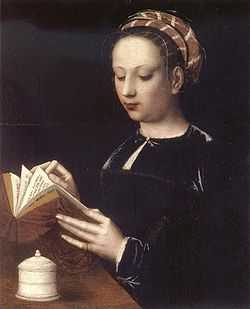
Ambrosius Benson (c. 1495/1500, Ferrara or Milan[1] – 1550, Flanders) was an Italian painter who became a part of the Northern Renaissance.
While many surviving paintings have been attributed, there is very little known of him from records, and he tended not to sign his work. He is believed to be responsible for mainly religious art, but also painted portraits on commission. He sometime painted from classical sources, often setting the figures in modern-dress, or a contemporary domestic setting.[2] In his lifetime he was successful; he had a large workshop, his work was sold internationally and he was especially popular in Spain.[3]
Benson became popular as a source for pastiche with 19th-century painters, who are sometimes known as the "followers of Benson". In particular his many variations of the Magdalen and Sibilla Persica were further copied and became popular with contemporary buyers. Many have retained their relative value and held in the National Gallery, London and command high prices at Sotheby's.[4][5]
Life
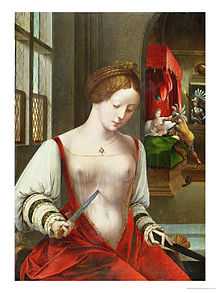
Typical of the itinerant manner of many painters of the time, he moved to Bruges c. 1515 and served his apprenticeship with the Early Netherlandish painter Gerard David. He later became a naturalized citizen of Bruges.[3] Benson worked as a journeyman before he was made master in 1519 and became a member of the guild of painters and saddlemakers.[6] He eventually became a dean and then and governor of the guild. He married Anna Ghyselin, and had two sons with her, Jan and Willem, both of whom became painters. He later remarried and had a daughter Anna. He is believed to have had at least two other daughters from extra-marital affairs.
Benson came into dispute with Gerard around 1519, over a number of paintings and drawings Benson had created -including a book of studies for heads and nudes as well as various patterns- in the older master's workshop without his assistance. David refused to return the material, and after Benson pursued him legally, served time in prison for his appropriation.[7][8]
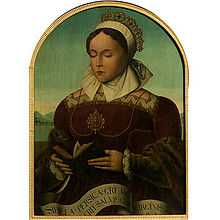
He served as head of the Guild of Saint Luke from 1537 to 1539 and 1543 to 1544. Much of his work was at one time attributed to a Spanish artist known only as the Master of Segovia; it is now believed they were the same person.
Perhaps under the influence of Rogier van der Weyden's 15th-century The Magdalen Reading, Benson was one of the first artists to popularise images of women reading. It became a motif for him, and he painted the scene many times in his images of Mary Magdalen and the Sybil Persica, whom he treated as almost interchangeable.[9]
Gallery
-
The Descent from the Cross, 1528
-
.jpg)
The Magdalen Reading, 1535
-
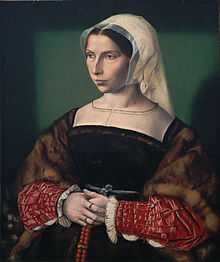
Portrait of Anne Stafford, 1535
-
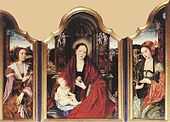
Virgin with Pear, date unknown
-
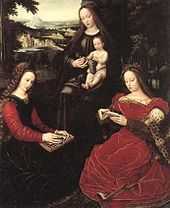
Virgin and Child with Saints, date unknown
-
Deipara Virgo, date unknown
References and sources
- References
- ↑ His original name was likely Benzone or Bensoni, or a variation
- ↑ See his Death of Lucretia, First wife of Lucius Colatinus Tarquinius, above
- ↑ 3.0 3.1 Rundle, 1999
- ↑ "The Magdalen Reading". National Gallery, London. Retrieved 29 December 2010
- ↑ Virgin and Child in a Landscape. Sothebys, 10 December 2009. Retrieved 29 December 2010
- ↑ "Ambrosius Benson. National Gallery, London. Retrieved 29 December 2010
- ↑ Nash, Susie. Northern Renaissance art. Oxford University Press, 2008. 168, 193. ISBN 0-19-284269-2
- ↑ Scheller, Robert W. Exemplum: Model-Book Drawings and the Practice of Artistic Transmission in the Middle Ages (c. 900-c. 1470). Amsterdam: Amsterdam University Press, 1995. 79
- ↑ 9.0 9.1 "Sibilla Persica". Victoria and Albert Museum. Retrieved 29 December 2010
- Sources
| Wikimedia Commons has media related to Ambrosius Benson. |
- Friedländer, Max J. "Ambrosius Benson as a Portrait Painter". "Yearbook of the Prussian art collections", 1910. 31
External links
- Gerard David: purity of vision in an age of transition, an exhibition catalog from The Metropolitan Museum of Art (fully available online as PDF), which contains material on Benson (see index)
|